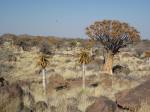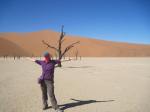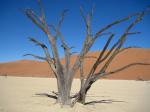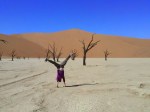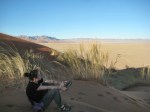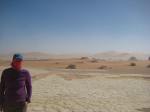The second country that we visited on our self-drive safari was Nambia. We had heard a lot of great things about the wildlife and natural beauty to be found in the country!
Safari Night 11 – Camp Kwando, On The Kwando River near Kongola
Getting There
Our exit from Botswana and into Namibia was almost shockingly easy. The border at Ngoma was very sleepy – we were the only ones crossing at the time so we didn’t have to wait in any lines. We gave one of the final guards some water, so I guess that was a bribe?
Most of the roads we drove on were paved, so no stress there.
Campsite
Camp Kwando felt almost like a resort. We were the only ones camping in the main public campground so we got to pick the best spot. The site itself was covered with nice grass and had a lot of trees.
Ablutions
There was a small rondavel near the site we picked that had a (flush) toilet and sink. There was a communal ablutions with showers a short walk away. The furnishings were pretty fancy and the water was hot.
Amenities
This camp was clearly catering to a fancy crowd. It had a very nice open-air reception, bar and restaurant that overlooked the river. We spent time here reading and admiring the views.
-

-
We had our pick of sites! We decided to stay close to ablutions
-

-
The fancy reception/bar/restaurant
-
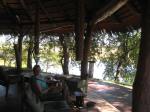
-
Relaxing at the bar overlooking the river
-

-
Sunset over the Kwando
Safari Night 12 – Ngepi Camp, On The Okavango River near Divundu
Getting There
We had an easy day of driving down the Trans-Caprivi highway. We could tell this camp was going to have a different spirit based on some of the humorous signs that marked the way into camp.
Campsite
We had a nice site with our own private area for looking out over the river. There was grass in the site, but we had to park our car on dirt and thus set up our tent there. During dinner, we really enjoyed watching a family of elephants across the river.
Ablutions
Definitely fit in with the funky vibe. All facilities were outdoors and with no coverings. We didn’t take a shower since they didn’t look very nice. We heard that other bathrooms in the campground had different themes, but we didn’t investigate.
Amenities
This definitely had a hostel vibe to it. There was a communal hang-out area with a fireplace and a bar. We stayed up later normal at night by this fire, conversing with some of the other guests and the staff running the place, who were all males who were in their 20s. The bar became quite the scene later in the evening when a group of American college students on an overland tour decided to order a ton of drinks and behave pretty crazily.
There was also a few nice patios out over the water where we spent a lot of time reading, relaxing and looking for hippos.
-

-
Funny sign on the drive in
-

-
Our site
-

-
Looking from the site back to the truck
-
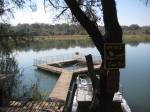
-
Swimming pool in the river (we didn’t use because the water was cold)
-
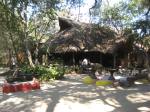
-
Common area – got pretty wild at night!
-
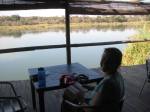
-
Reading overlooking the river
-

Safari Night 13 – n’Kwazi Lodge, On The Okavango River near Rundu
Getting There
Another easy day of driving on the Trans-Caprivi
Campsite
Most of the campground was pretty unattractive, mostly a big grassy area, but we did get our own walled-off area to ourselves.
Ablutions
A large building with only lukewarm water
Amenities
There was a nice lodge with comfortable chairs, good shade, and most importantly… free, fast wi-fi!
Activities
We attended a nice dance performance put on by a group of local villagers.
-

-
Our site with a fence around it
-

-
We splurged on lunch in the lodge
-

-
The dance performance
Safari Night 14, 15, 16 – Halali Camp, Etosha National Park
Getting There
We took a Google-recommended shortcut and had our first experience with Namibian gravel roads. It wasn’t that bad actually! And we stopped at a monument for a giant baobab tree.
Campsite
The site was pretty unattractive. There were just large patches of dirt which were split off into different camps. Not much privacy from the neighbors! We did enjoy the provided table and light though.
Ablutions
Nice, hot water with good water pressure for showers.
Amenities
There was a restaurant which we decided to eat at twice – once for lunch and once for a buffet dinner (we decided to splurge). There was also a small convenience store. There was also a swimming pool, but we never took the plunge.
Activities
By far the coolest thing to do here was to walk to the waterhole they had set up for viewing. Compared to the Botswana parks, this felt very different! The park had made an artificial pool, then set up a large tiered viewing area with benches and shade where we could watch the animals come drink. And it was floodlit, so it was open 24 hours! We spent a lot of time just relaxing and watching animals here.
Also, one morning we took a trail up the small hill behind camp, which afforded great views of the area.
Probably the most popular activity, and for good reason, was to do a game drive – you are in the middle of the National Park after all. We did multiple and were amazed by how many different animals we saw – and how much easier it was to see them here than in Botswana. The roads were much nicer as well.
-
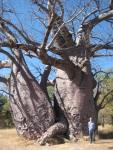
-
Giant Baobab tree on the way
-

-
The site
-

-
View from the hill
-
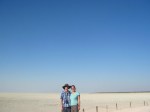
-
The Etosha Pan
-

-
Sunset at the waterhole
-

Safari Night 17 – Abu-Huab Camp, near Twyfelfontein
Getting There
We had heard about cheetah farms in the area and were interesting in investigating, since we hadn’t yet seen a cheetah and it sounded pretty neat. One of the original ones we were considering would be a significant detour, so we weren’t sure what to do. So when we saw a small camp right off the road that offered cheetah feedings, we decided to do just that. We got a chance to feed two cheetahs, which was pretty fun.
The last stretch of driving to the camp switched to a dirt road that went into some hills. It got a little twisty, but not the worst road we’ve ever been on. Got pretty scenic too.
We got a little lucky finding the camp: we had a map that showed its location as being on a road that didn’t exist, but luckily we spotted the camp just off the road on the way to Twyfelfontein.
Campsite
On the bank of the Abu Huab river – but with no water! We found that in Namibia they had a lot of rivers listed on maps that only rarely flow. We were able to pick a nice spot with a big tree and river access. When it was windy in the afternoon we even read books down in the river.
Ablutions
In a random building somewhat far from the sites. The hot water was heated by a wood-fired burner, so we decided not to test the temperature for showers.
Amenities
There was a small bar, pool table and even a sitting area that looked like it could have served as a restaurant. It all seemed pretty dead though, so we didn’t test any of these out.
Activities
See Tywfelfontein post
Safari Night 18 – Alte Brucke Campground, Swakopmund
Getting There
See Skeleton Coast post for the drive to Swakopmund
Within Swakopmund, we had an interesting adventure. Eric had written down some basic directions from Google Maps, and we had a map of the town from the 1999 Lonely Planet. However, as we were driving into town, we realized that the street names had almost all changed since 1999! We spent some panicky moments trying to orient ourselves (exacerbated by the fact that we hadn’t really driven in an urban environment since day 1). Eventually, we found a road that had the same name as on the 1999 map, and we made our way to the campground.
Campsite
This was a new setup for us: each site had its own patch of grass with a its own structure attached.
Ablutions
Inside this structure was our own private ablutions area! We definitely enjoyed the showers that we took here.
Amenities
There was wi-fi in the sites… but we had to pay almost $5 US dollars to use it. The signal would go in and out too, which was frustrating.
Activities
The campground was within walking distance of the central parts of Swakopmund. We enjoyed walking out on the jetty, and walking through town spotting the historic German buildings.
-

-
Our site- with our private ablutions!!
-
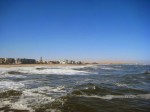
-
The town of Swakopmund – see the dunes in the distance
-
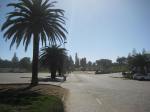
-
The lighthouse
-

-
Colonial German architecture
Safari Night 19 – Solitaire Guest Farm Desert Ranch, Solitaire
Getting There
The first section of the road went by some pretty dunes. It was pretty windy though, so there was lots of blowing sand.
As we got away from the coast, we went back into some mountainous terrain and crossed two passes (not quite as hard as Colorado passes). We also passed a sign for the Tropic of Capricorn.
Campsite
This seemed like a higher-end facility and had mostly lodge rooms. There were only three campsites, and all were pretty fancy. They were large sites with a fence around each.
Ablutions
Again, we got our own ablutions block! This one even had enough space inside that we decided to cook and eat dinner in it to get out of the wind.
Amenities
There was a bar, two swimming pools and free wi-fi.
Activities
The was a small hill within walking distance of the camp that made for an excellent place to view the sunset.
-

-
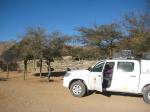
-
The site
-

-
Checking out the pool temp… It was cold.
-

-
Solitaire Guest Farm Desert Ranch
-

-

-
Our private ablutions (and wind) block
Safari Night 20,21 – Sesriem Campground, Namib Nakluft National Park
Getting There
This was only about an hour’s drive from Solitaire, so probably our easiest driving day of the entire trip.
Campsite
Each site was surrounded by a low stone wall and had a large tree in it.
Ablutions
Not the prettiest inside or out, but nice hot water.
Amenities
There was a bar with a large indoor seating area that we used one afternoon, and also a convenience store.
Activities
See Sossusvlei post
-
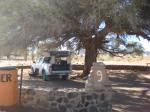
-
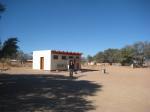
-
Coming back from ablutions
Safari Night 22 – Quivertree Forest Reserve, Outside Keetmanshoop
Getting There
The safari was basically over at this point, and this was the first of three long days of driving to get back to Johannesburg.
Campsite
This was a large campground with a lot of sites to choose from. We didn’t know if it was just a low season or if this place had seen better days. Scarred from the previous windy nights, we spent a while trying to find a site that seemed to have good wind protection. There wasn’t a lot of privacy between the small sites, but it didn’t matter since it was so empty.
Ablutions
There were a lot of little ablutions scattered around. There was nice hot water so we enjoyed our showers.
Amenities
Not much to speak of that we used.
Activities
We spent some time exploring the Quivertree Forest that the camp is set right next too. We definitely enjoyed exploring these very strange looking trees – they felt like something out of Dr. Seuss! We also had fun spotting all of the rock hyraxes that lived in the forest.
Also, the manager of the camp had a (free!) viewing of him feeding cheetahs in the afternoon.

































 The Skeleton Coast felt like we were on another world.
The Skeleton Coast felt like we were on another world.



 We enjoyed the southern African version of waysides or picnic areas. We would see a sign for a table under a tree… and then you’d always see the table under the tree!
We enjoyed the southern African version of waysides or picnic areas. We would see a sign for a table under a tree… and then you’d always see the table under the tree!









































